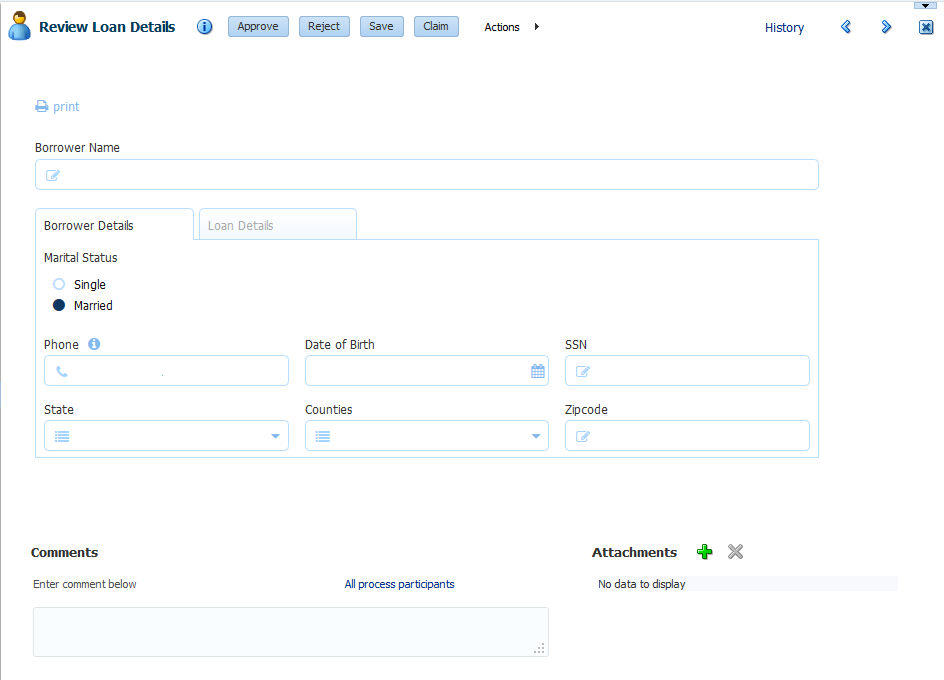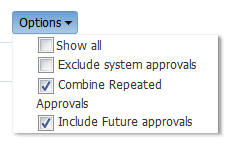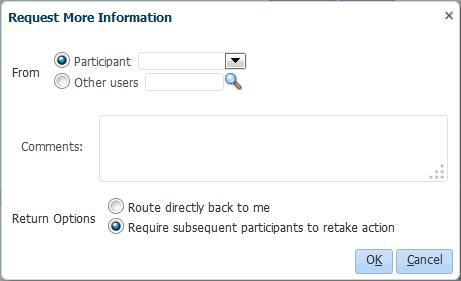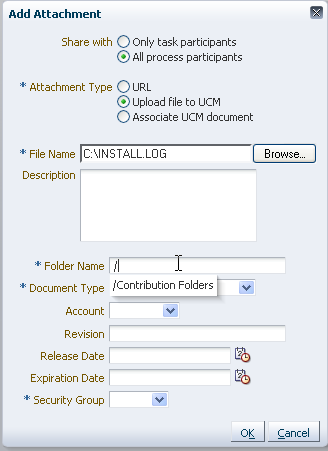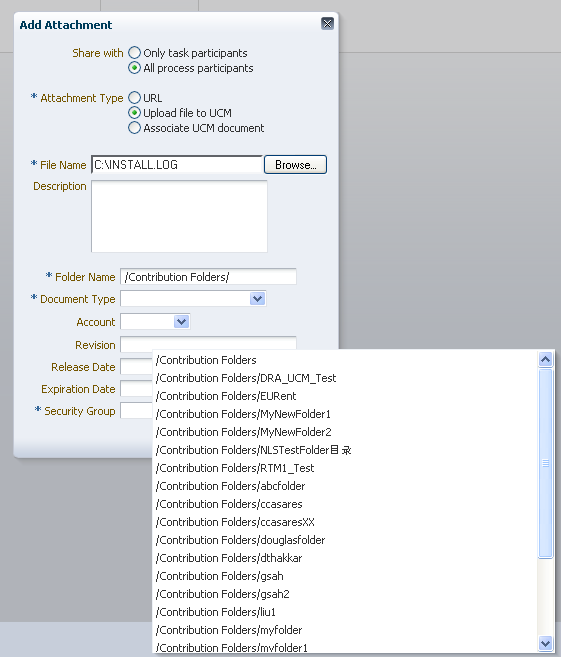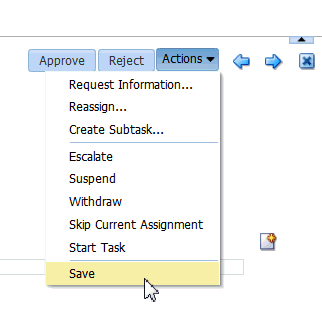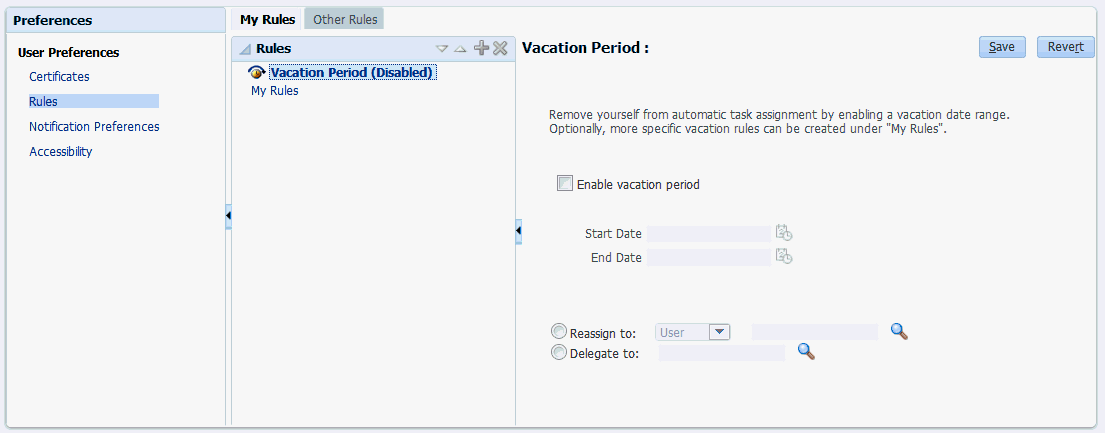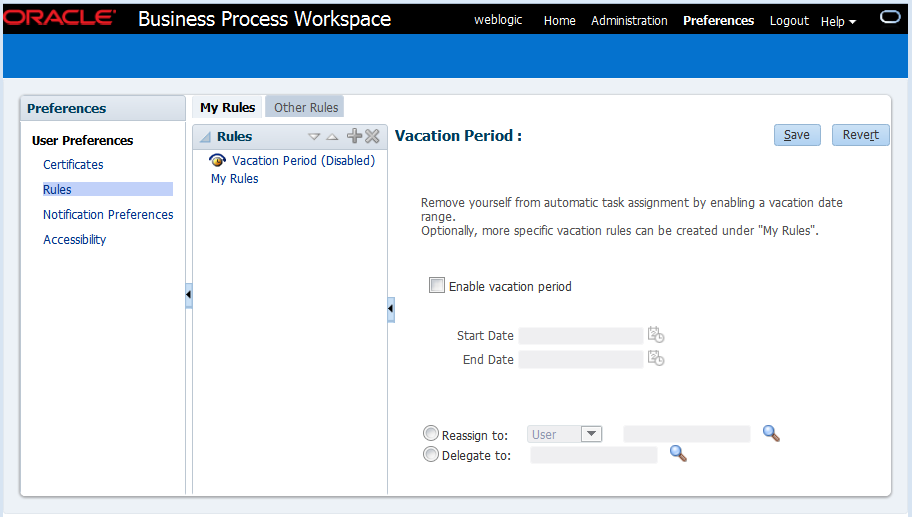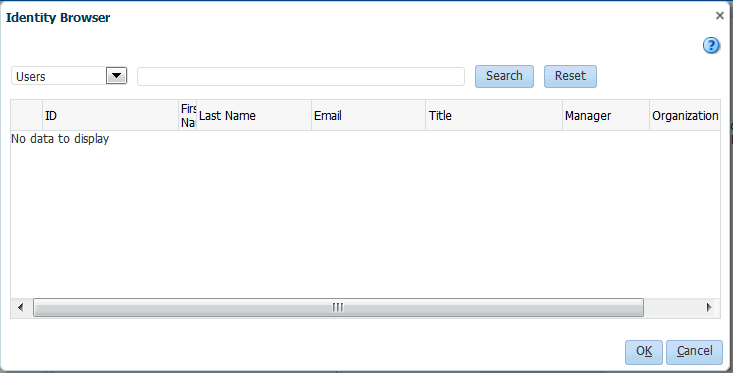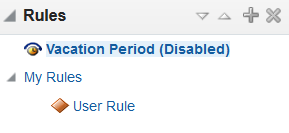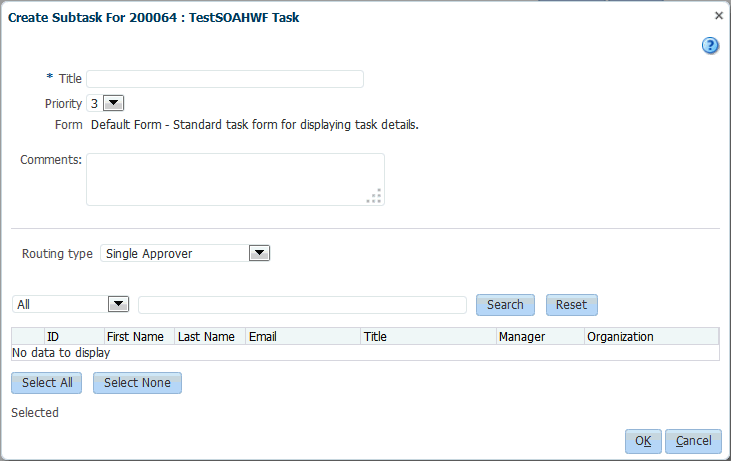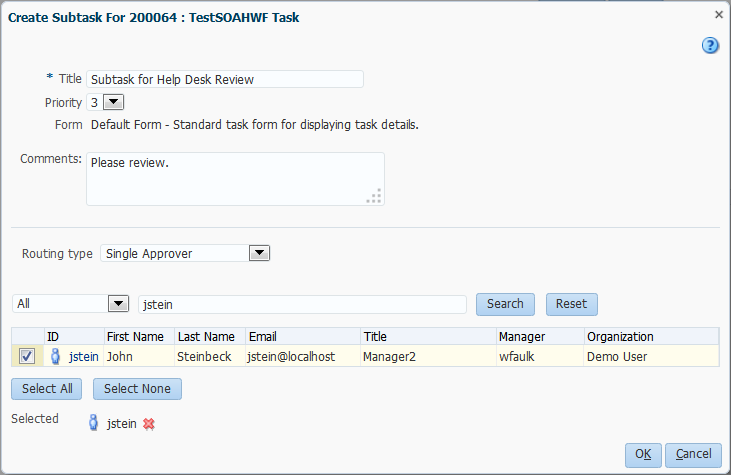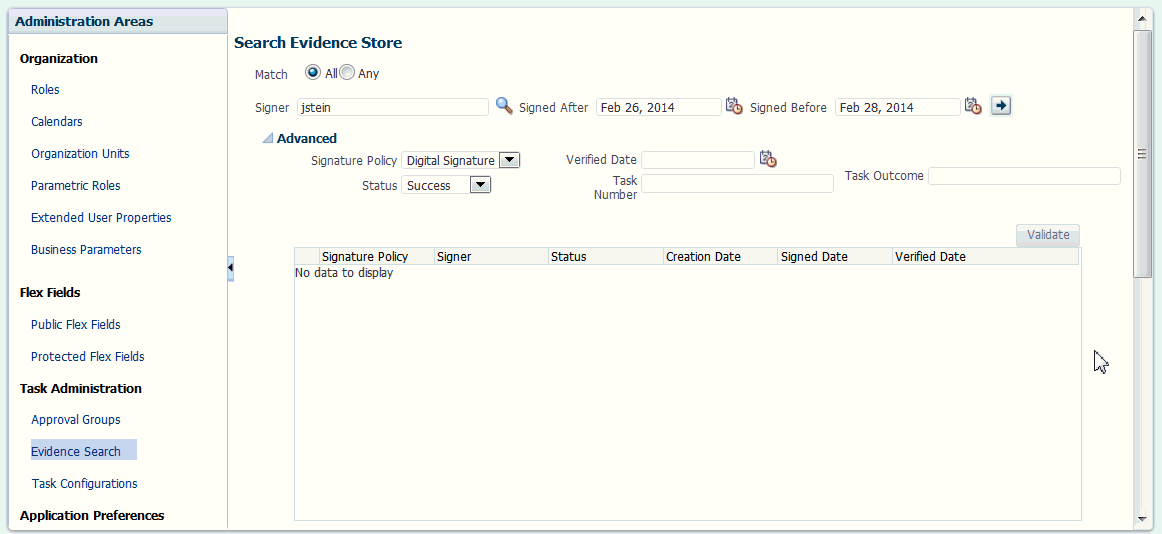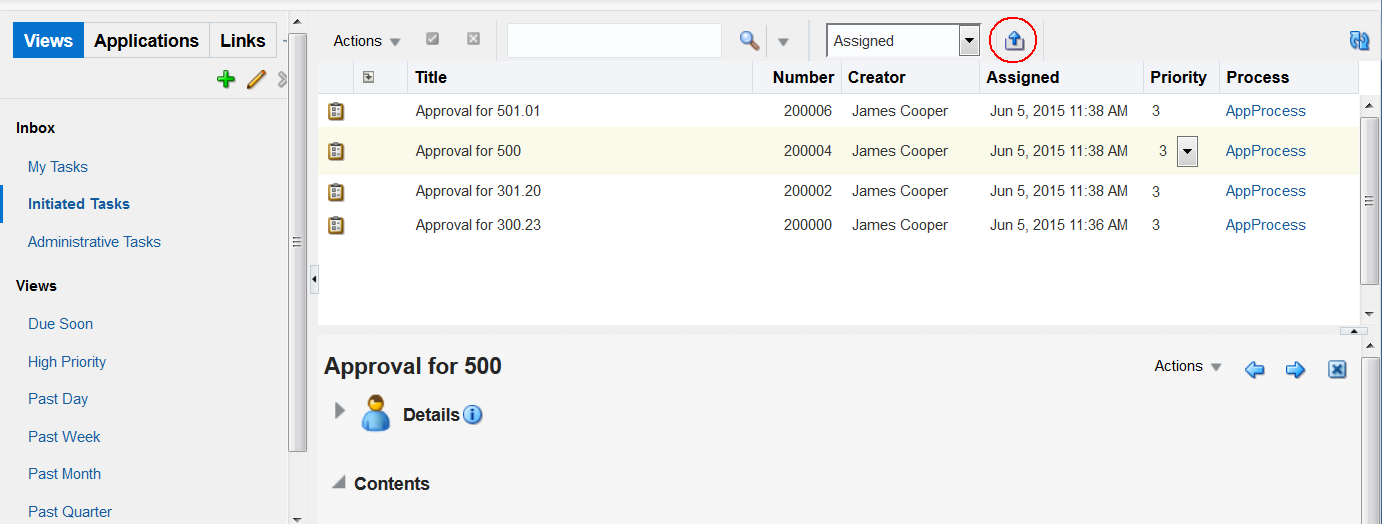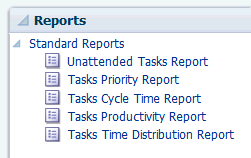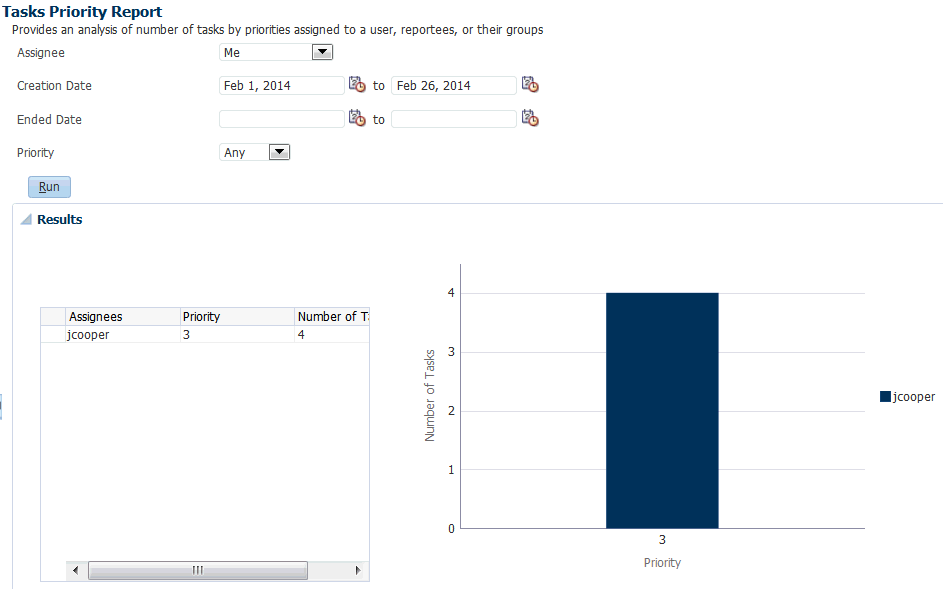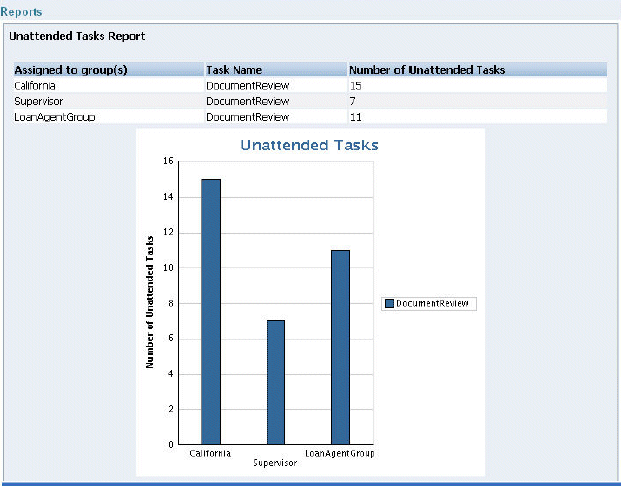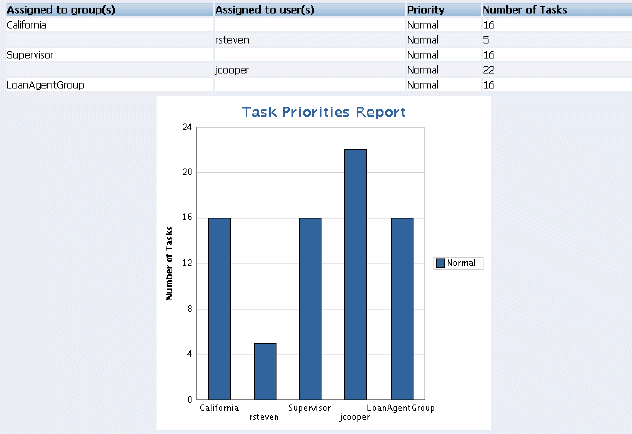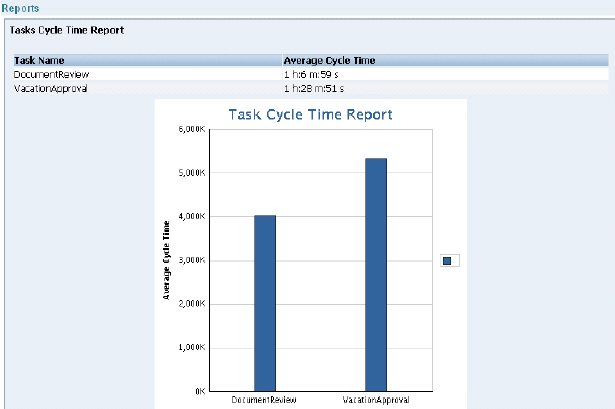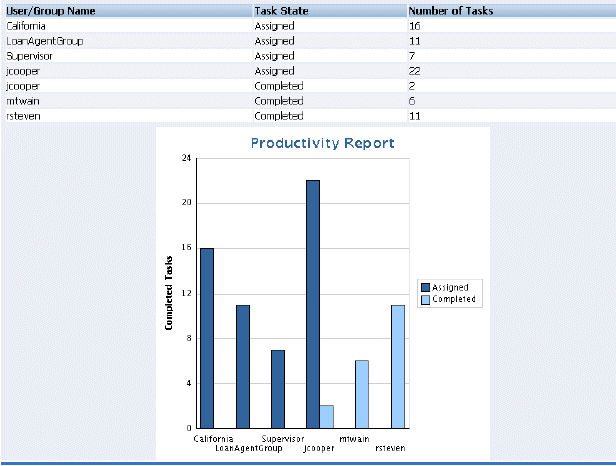2 Working on Tasks in Process Workspace
You can set user preferences and act on tasks with Oracle Business Process Management Workspace (Process Workspace), including claiming and releasing tasks; reassigning, delegating, and routing tasks; associating comments and attachments to tasks, and setting rules and vacation periods.
2.1 Claiming and Releasing Tasks in Process Workspace
If a task is assigned to a group or multiple users, then the task must be claimed first. Claim is the only action available in the Task Action list for group or multiuser assignments. After a task is claimed, all applicable actions are listed.
Note:
If the task has the auto claim option set, then the user must not claim the task. The custom action is available for the user.
If a task is assigned to a group or multiple users, it can be released by the user who claimed it. Any of the other assignees can then claim and complete the task.
Note:
Workspace does not concurrently update tasks by multiple users. If this happens, you may see the message "error occurred while committing the task metadata".
To claim and release tasks:
To claim a task, open it in the Task Details page, then click the Claim button. Figure 2-1 shows a Task Details page with the Claim button in the top middle of the page.
To release a task, open it in the Task Details page, from the Actions list, select Release.
2.2 Modifying History Approval Options in the Task Details Page
You can modify approval options and add new participants to tasks.
This section includes the following topics:
2.2.1 Combining Repeated Approvals of a Task in the History
At times you may want to combine tasks that have identical approval sequences into one combined approval—for example, to approve a purchase order that has many identical line items each requiring its own approval. Rather than approving each line item one-by-one, you can combine them into a single approval and then approve that combined task.
After you combined tasks into one repeated approval, you cannot alter the sequence of those tasks; for example, you cannot add, edit, or delete a participant in that task.
To combine repeated approvals of a task:
2.2.2 Excluding System Approvals from a Task
To remove all system generated updates from the task history, you must select the option to exclude system approvals.
To select Exclude System Approvals:
2.2.3 Including New Participants in the History Table for an Existing Task
To include new participants in a task, you must select the Including Future Approvals option from the task history. This option adds participants to the task history and displays the actions they perform on the task.
This is enabled only when the task is configured with the following options:
-
Participants are allowed to invite other participants
-
Editing of future approvers is allowed
To Include New Participants:
2.3 Reassigning and Delegating Tasks in Process Workspace
You may go on vacation and need to reassign your tasks to someone else, or you may need to delegate your tasks to an administrative assistant.
To reassign or delegate a task:
2.4 Requesting Information in Process Workspace
You can request more information about a task from another user.
To request information:
2.5 Adding Comments and Attachments to Tasks in Process Workspace
You can add comments and attachments to a task using the Task Details page.
This section includes the following topics:
For details about the Task Details page, see Using the Process Workspace Task Details Page.
2.5.2 How to Add an Attachment to a Task
You can add an attachment to a task. However, you cannot add documents to a human task using task user interface once the task is associated with a case.
To add an attachment to a task:
2.6 Setting Rules, Vacation Periods, and Notification Preferences in Process Workspace
Rules act on tasks, either a specific task type or all the tasks assigned to a user or group.
To set rules, from the Process Workspace global toolbar, select Preferences. The Preferences window appears as shown in Figure 2-9.
A rule cannot always apply to all circumstances in which it is used. For example, if a rule applies to multiple task types, it may not be possible to set the outcome for all tasks, because different tasks can have different outcomes.
Rules are executed in the order in which they are listed.
If a rule meets its filter conditions, then it is executed and no other rules are evaluated. For your rule to execute, you must be the only user assigned to that task. If the task is assigned to multiple users (including you), the rule does not execute.
You cannot specify business rules for To-Do tasks.
This section contains the following topics:
2.6.1 How to Create User Rules in Process Workspace
Note:
The task type browser does not support a search using NLS strings for task name and category.
To create a user rule:
The new rule appears under the My Rules node.
2.6.2 How to Create Group Rules in Process Workspace
Note:
The task type browser does not support a search using NLS strings for task name and category.
Creating a group rule is similar to creating a user rule, with the addition of a list of the groups that you (as the logged-in user) manage. Examples of group rules include:
-
Assigning tasks from a particular customer to a member of the group
-
Ensuring an even distribution of task assignments to members of a group by using round-robin assignment
-
Ensuring that high-priority tasks are routed to the least busy member of a group
Group rules do the following actions:
-
Assign to member via—You can specify a criterion to determine which member of the group gets the assignment. This dynamic assignment criterion can include round-robin assignment, assignment to the least busy group member, or assignment to the most productive group member. You can also add your custom functions for allocating tasks to users in a group.
-
Assign to—As with user rules, you can assign tasks to subordinates or groups you directly manage. If you have been granted the BPMWorkflowReassign role, then you can reassign tasks to any user or group (outside your management hierarchy).
-
Take no action—As with user rules, you can create a rule with a condition that prevents a more generic rule from being executed.
To create a group rule:
2.6.3 How to Enable a Vacation Period in Process Workspace
You can set a vacation period so that you are removed from automatic task assignment during the dates you specify.
Vacation rules are not executed for To-Do tasks.
For instructions on setting a vacation rule that is synchronized with the vacation period, see How to Create User Rules in Process Workspace.
To enable a vacation period:
2.6.4 How to Avoid Circular Logic in Reassigned Vacation Rules
When creating vacation rules, ensure that approval tasks are not reassigned in a circular fashion.
For example, jstein is jcooper’s manager, and tasks that need to, go to jstein for approval. If jstein creates a vacation rule, ensure that those tasks will not be re-assigned to jcooper.
Alternatively, you can use the delegate option in vacation rules instead of reassign. For more information about the delegate option, see Reassigning and Delegating Tasks in Process Workspace.
How To Avoid Circular Dependency
In this example, we define two rules for User2, who wants to set a vacation period and reassign his tasks to someone else. The first rule states that if the task is not coming from User1, then reassign it to User1. The second rule states that if the task is coming from User1, then reassign it to User3.
The task flow is: jcooper to jstein to wfaulk. The rules are set for jstein.
2.6.5 How to Specify Notification Settings
You can configure the notification settings to control how, when, and where you receive messages in cases when you have access to multiple communication channels (delivery types). Specifically, you can define messaging filters (delivery preferences) that specify the channel to which a message should be delivered, and under what circumstances.
For example, you might want to create filters for messages received from customers with different Service Level Agreements (SLA), specifying to be notified through business phone and SMS channels for customers with a premium SLA and by EMAIL for customers with a nonpremium SLA.
2.6.5.1 Messaging Filter Rules
A messaging filter rule consists of rule conditions and rule actions. A rule condition consists of a rule attribute, an operator, and an associated value. A rule action is the action to be taken if the specified conditions in a rule are true.
2.6.5.1.1 Data Types
Table 2-1 lists data types supported by messaging filters. Each attribute has an associated data type, and each data type has a set of predefined comparison operators.
Table 2-1 Data Types Supported by Messaging Filters
| Data Type | Comparison Operators |
|---|---|
|
Date |
isEqual, isNotEqual, isGreaterThan, isGreaterThanOrEqual, isLessThan, isLessThanOrEqual, Between, isWeekday, isWeekend |
|
Time |
isEqual, isNotEqual, Between |
|
Number |
isEqual, isNotEqual, Between, isGreaterThan, isGreaterThanOrEqual, isLessThan, isLessThanOrEqual |
|
String |
isEqual, isNotEqual, Contains, NotContains |
Note:
The String data type does not support regular expressions.
2.6.5.1.2 Attributes
Table 2-2 lists the predefined attributes for messaging filters.
Table 2-2 Predefined Attributes for Messaging Filters
| Attribute | Data Type |
|---|---|
|
Total Cost |
Number |
|
From |
String |
|
Expense Type |
String |
|
To |
String |
|
Application Type |
String |
|
Duration |
Number |
|
Application |
String |
|
Process Type |
String |
|
Status |
String |
|
Subject |
String |
|
Customer Type |
String |
|
Time |
Time |
|
Group Name |
String |
|
Processing Time |
Number |
|
Date |
Date |
|
Due Date |
Date |
|
User |
String |
|
Source |
String |
|
Amount |
Number |
|
Role |
String |
|
Priority |
String |
|
Customer Name |
String |
|
Expiration Date |
Date |
|
Order Type |
String |
|
Organization |
String |
|
Classification |
String |
|
Service Request Type |
String |
2.6.5.2 Rule Actions
For a given rule, a messaging filter can define the following actions:
-
Send No Messages: Do not send a message to any channel.
-
Send Messages to All Selected Channels: Send a message to all specified channels in the address list.
-
Send to the First Available Channel: Send a message serially to channels in the address list until one successful message is sent. This entails performing a send to the next channel when the current channel returns a failure status. This filter action is not supported for messages sent from the human workflow layer.
2.6.5.3 Managing Messaging Channels
In Oracle BPM Worklist, messaging channels represent both physical channels, such as business mobile phones, and also email client applications running on desktops. Specifically, Oracle BPM Worklist supports the following messaging channels:
-
EMAIL
-
IM
-
MOBILE
-
SMS
-
WORKLIST
Note the following about message channels:
-
Addresses for messaging channels are fetched from the configured identity store.
-
SMS and MOBILE notifications are sent to the mobile phone number.
-
No special notification is sent when the messaging channel preference is WORKLIST. Instead, log in to Oracle BPM Worklist to view tasks.
-
EMAIL is the default messaging channel preference when a preferred channel has not been selected.
You can use the Messaging Channels tab to view, create, edit, and delete messaging channels.
2.6.5.3.1 Viewing Your Messaging Channels
You can display your existing messaging channels.
To view messaging channels:
-
From the Process Workspace global toolbar, select Preferences.
The Preferences pane is displayed.
-
In the User Preferences area, click Notification Preferences.
-
Expand Available Channels.
The Available Channels list appears (Figure 2-13) and displays the following information:
-
Name: The name of the messaging channel.
-
Type: The type of messaging channel, such as EMAIL or SMS.
-
Address: The address for the channel, such as a phone number or email address.
-
Default: Specifies whether this channel is the default messaging channel.
Figure 2-13 Available Channels and Messaging Filters
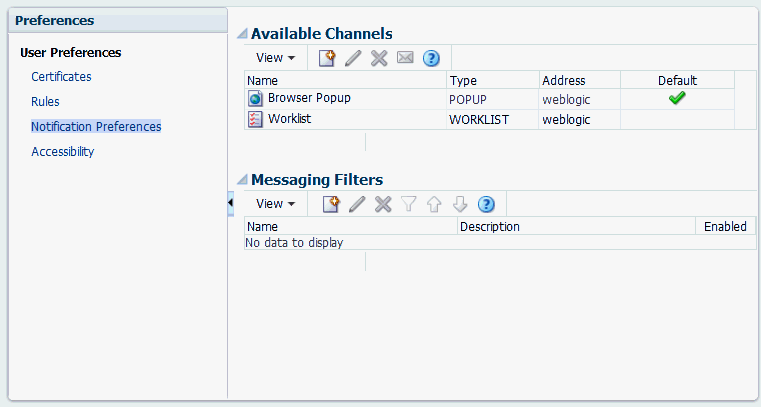
Description of "Figure 2-13 Available Channels and Messaging Filters" -
-
Click View, click Columns and select the columns to display or hide.
You can also click View > Reorder Columns to display a dialog to reorder the displayed columns.
Messaging channel names and addresses are retrieved from the underlying identity store, such as Oracle Internet Directory.
2.6.5.3.2 Creating, Editing, and Deleting a Messaging Channel
Oracle BPM Worklist uses an underlying identity store, such as Oracle Internet Directory, to manage messaging channels and addresses. Therefore, you cannot directly create, modify, or delete messaging channels using Oracle BPM Worklist.
To perform these actions, contact the system administrator responsible for managing your organization's identity store.
2.6.5.4 Managing Messaging Filters
You can use the Messaging Filters tab to define filters that specify the types of notifications you want to receive along with the channels through which to receive these notifications. You can do this through a combination of comparison operators (such as is equal to, is not equal to), attributes that describe the notification type, content, or source, and notification actions, which send the notifications to the first available messaging channels, all messaging channels, or to no channels (effectively blocking the notification).
For example, you can create a messaging filter called Messages from Lise, that retrieves all messages addressed to you from your boss, Lise. Notifications that match all of the filter conditions might first be directed to your business mobile phone, for instance, and then to your business email if the first messaging channel is unavailable.
2.6.5.4.1 Viewing Messaging Filters
You can display your existing messaging filters.
To view your messaging filters:
-
From the Process Workspace global toolbar, select Preferences.
The Preferences pane is displayed.
-
In the User Preferences area, click Notification Preferences.
-
Expand Messaging Filters.
The Messaging Filters list appears and displays the following information:
-
Filter Name: The name of the messaging filter.
-
Description: An optional description of the messaging filter.
-
-
Click View, click Columns and select the columns to display or hide.
You can also click View > Reorder Columns to display a dialog to reorder the displayed columns.
2.6.5.4.2 Creating Messaging Filters
To create a messaging filter:
-
Click Create.
The Create Filter dialog box appears, as shown in Figure 2-14.
-
Specify the following information:
-
Filter Name: The name of the messaging filter.
-
Description: An optional description for the messaging filter.
-
Enabled: By default this option is checked. Uncheck if you do not want this filter used in message handling.
-
-
Select whether notifications must meet all of the conditions or any of the conditions by selecting either the match all of the following conditions or the match any of the following conditions options.
-
Click Create.
Define the filter conditions in the Create Condition dialog box as follows:
-
Select the attribute from the list.
-
Select the operator, such as isEqual, from the list.
-
Type the value of the condition in the text box.
-
Click OK to add the condition to the list.
-
Repeat these steps to add more filter conditions. To remove a filter condition, click Delete.
-
-
Select from the following messaging options in the Action section:
-
Do not send messages: Do not send a message to any channel.
-
Send to first available channel: Send a message serially to channels in the address list until one successful message is sent. This entails performing a send to the next channel when the current channel returns a failure status.
-
Send to all selected channels: Send a message to all specified channels in the address list.
-
-
To set the delivery channel, select a channel from the Add Notification Channel list and click Add. To remove a channel, click Delete.
-
Use the up and down arrows to prioritize channels. If available, the top-most channel receives messages meeting the filter criteria if you select Send to the First Available Channel.
-
Click OK.
The messaging filter appears under the Messaging Filters area. The Messaging Filters area enables you to edit or delete the channel. Click Cancel to dismiss the dialog without creating the filter.
2.6.5.4.3 Editing a Messaging Filter
To edit a messaging filter:
-
Select the filter from the Messaging Filters area.
-
Click Edit.
-
Click OK to update the messaging filter. Click Cancel to dismiss the dialog without modifying the filter.
2.7 Creating To-Do Tasks in Process Workspace
You can create a To-Do task for yourself or for others. To-Do tasks are not associated with business tasks.
Use the Create To-Do Task dialog, shown in Figure 2-15, to create a top-level To-Do task for yourself or others.
Figure 2-15 The Create To-Do Task Dialog Box
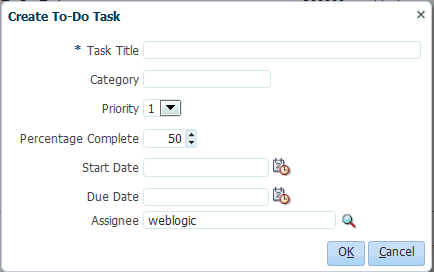
Description of "Figure 2-15 The Create To-Do Task Dialog Box"
To-Do tasks appear in the assignee's Inbox.
To-Do tasks can be reassigned, escalated, and so on, and deleted (logical delete) and purged (physical delete). Reassignment, escalation, and so on of the task does not affect the assignment of any child To-Do tasks. The completion percentage of a To-Do task can be reset to less than 100 percent after it is completed.
Assignment rules (such as vacation rules) are not applied to To-Do tasks. You cannot specify business rules for To-Do tasks.
To create a To-Do task:
2.8 Creating Subtasks in Tasks in Process Workspace
A subtask is a child of a task, either a To-Do task or a business task.
Creating a subtask can be helpful, for example, when a purchase order contains several line items and you need a separate approval process for one of them.
2.8.1 What You May Need to Know About Creating Subtasks
Here are some important points to keep in mind when creating subtasks:
-
A To-Do task can only have To-Do subtasks. When all To-Do subtasks are 100 percent complete, the To-Do task is also marked as complete. If the To-Do task is completed, then To-Do subtasks are at 100 percent within the workflow system.
If the task is a business task and that task is completed, then the subtasks of that task are withdrawn. You can only create a business tasks for other business tasks.
-
If you explicitly set a To-Do task to 100 percent, there is no aggregation on the task.
-
If you are using a release of Oracle BPM that is prior to 11g Release 1 (11.1.1.7.0), then, when you create a subtask from the Actions list of the task list, that subtask appear in the task list of the assignee for that subtask.
However, to enable subtask creation from the Actions list of the task details page and display of subtask section in the task details page, you must re-generate the form by using 11g Release 1 (11.1.1.7.0). You may continue to use processes that were deployed in earlier releases even if you do not re-create the task form.
-
Sub Tasks created in Process Workspace are not included as composite audit trail in Oracle Enterprise Manager Cloud Control Console.
-
Parallel tasks are created when a parallel flow pattern is specified for scenarios such as voting. In this pattern, the parallel tasks have a common task. You can create subtasks using different pattern lines: Single approver, Sequential approver and Parallel approver.
The subtasks are included in the Tasks Details page of the task. To view the subtasks for a task, select the task from the Task List to display the Task Details page. The subtasks are displayed under the Sub Tasks section.
2.9 Acting on Tasks that Require Passwords in Process Workspace
When you act to approve or reject a human task that was set up to require a password, you must provide the password when prompted.
2.10 Acting on a Task that Requires a Digital Signature in Process Workspace
A digital signature is an electronic signature that authenticates the identity of a message sender or document signer. This ensures that the original content of the message or document sent is unchanged.
Oracle Business Process Management Workspace supports the signature policy created in the human task:
-
No signature required — Participants can send and act on tasks without providing a signature.
-
Password required — Participants must specify their login passwords.
-
Digital certificate (signature) required —Participants must possess a digital certificate before being able to send and act on tasks. A digital certificate contains the digital signature of the certificate-issuing authority so that anyone can verify that the certificate is real. A digital certificate establishes the participant's credentials. It is issued by a certification authority (CA). It contains your name, a serial number, expiration dates, a copy of the certificate holder's public key (used for encrypting messages and digital signatures), and the digital signature of the certificate-issuing authority so that a recipient can verify that the certificate is real.
The evidence store service is used for digital signature storage and non-repudiation of digitally-signed human workflows.
For more information about digital signatures and the evidence store service, see Using the Evidence Store Service and Digital Signatures.
When you act on a task that has a signature policy, the Sign button appears, as shown in Figure 2-19.
Figure 2-19 Digital Signature Task Details
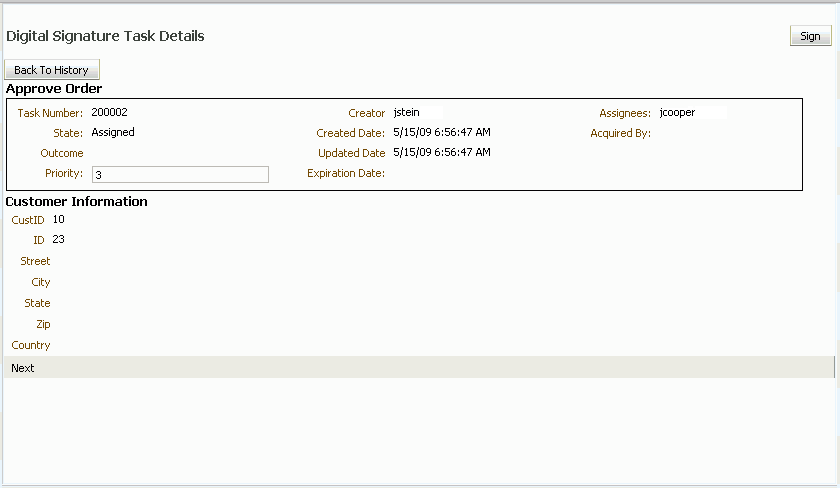
Description of "Figure 2-19 Digital Signature Task Details"
To use a certificate for digitally signing tasks, you must first upload the certificate as described in Providing a Digital Certificate in Process Workspace.
2.11 Routing Tasks in Process Workspace
If a human task was designed to permit ad hoc routing, the task can be routed in an ad-hoc fashion in the worklist.
For such tasks, a Route button appears on the task details page. From the Route Task dialog box, you can look up one or more users for routing. When you specify multiple assignees, you can select whether the list of assignees is for simple (group assignment to all users), sequential, or parallel assignment.
If you are a developer and want more information about designing tasks to permit ad hoc routing, see Oracle Fusion Middleware Developer's Guide for Oracle SOA Suite.
To route a task:
2.12 Using the Evidence Store Service and Digital Signatures
The evidence store service is used for digital signature storage and non-repudiation of digitally-signed human workflows. A digital signature is an electronic signature that authenticates the identity of a message sender or document signer. This ensures that the original content of the message or document sent is unchanged. Digital signatures are transportable, cannot be imitated by others, and are automatically time-stamped. The ability to ensure that the original signed message arrived means that the sender cannot repudiate it later.
Digital signatures ensure that a human workflow document:
-
Is authentic.
-
Has not been forged by another entity.
-
Has not been altered.
-
Cannot be repudiated by the sender.
A cryptographically-based digital signature is created when a public key algorithm signs a sender's message with a sender's private key.
During design time, signatures are enabled for the task. During runtime in Process Workspace, when a user approves or rejects the task, the web browser:
-
Asks the user to choose the private key to use for signing.
-
Generates a digital signature using the private key and task content provided by Oracle BPM Worklist.
Note:
-
The certificate refers to a Personal Information Exchange Syntax Standard (PFX) file that includes a certificate and a private key, and is protected by a simple text password. PFX specifies a portable format for storing or transporting a user's private keys, certificates, miscellaneous secrets, and so on.
-
The possession of a private key that corresponds to the public key of a certificate is sufficient to sign the data, because the signature is verifiable through the public key in the certificate. However, no attempt is made to correlate the name of a user of a certificate with the person updating it. For example, user jstein can sign using the private key of user cdickens if jstein has that private key.
The following digital signature features are supported:
-
PKCS7 signatures based on X.509 certificates.
-
Browser-based, digitally-signed content without attachments.
You can search the evidence store, as shown in Figure 2-22.
2.13 Exporting Tasks to Microsoft Excel
You can export tasks to Excel based on a selected view.
2.14 Creating Worklist Reports
Wroklist Reports include reports for Unattended Tasks, Tasks Priority, Tasks Cycle Time, Tasks Productivity, and Tasks Time Distribution.
Table 2-3 lists the worklist reports available for task analysis.
Table 2-3 Worklist Report Types
| Report Name | Description | Input Parameters |
|---|---|---|
|
Unattended Tasks |
Provides an analysis of tasks assigned to users' groups or reportees' groups that have not yet been acquired (the "unattended" tasks). |
|
|
Tasks Priority |
Provides an analysis of the number of tasks assigned to a user, reportees, or their groups, broken down by priority. |
|
|
Tasks Cycle Time |
Provides an analysis of the time taken to complete tasks from assignment to completion based on users' groups or reportees' groups. |
|
|
Tasks Productivity |
Provides an analysis of assigned tasks and completed tasks in a given time period for a user, reportees, or their groups. |
|
|
Tasks Time Distribution |
Provides the time an assignee takes to perform a task. |
|
2.14.1 How To Create Reports
Reports are available from the Reports link. Report results cannot be saved.
To create a report:
2.14.2 What Happens When You Create Reports
As shown in Figure 2-26, report results (for all report types) are displayed in both a table format and a bar chart format.
2.14.2.1 Unattended Tasks Report
Figure 2-27 shows an example of an Unattended Tasks report.
The report shows that the California group has 15 unattended tasks, the Supervisor group has 7 unattended tasks, and the LoanAgentGroup has 11 unattended tasks. The unattended (unclaimed) tasks in this report are all DocumentReview tasks. If multiple types of unattended task exists when a report is run, all task types are included in the report, and the various task types are differentiated by color.
2.14.2.2 Tasks Priority Report
Figure 2-28 shows an example of a Tasks Priority report.
The report shows that the California group, the Supervisor group, and the LoanAgentGroup each have 16 tasks of normal priority. The users rsteven and jcooper have 5 and 22 tasks, respectively, all normal priority. Priorities (highest, high, normal, low, lowest) are distinguished by different colors in the bar chart.
2.14.2.3 Tasks Cycle Time Report
Figure 2-29 shows an example of a Tasks Cycle Time Report.
The report shows that it takes 1 hour and 6 minutes on average to complete DocumentReview tasks, and 1 hour and 28 minutes on average to complete VacationApproval tasks. The bar chart shows the average cycle time in milliseconds.
2.14.2.4 Tasks Productivity Report
Figure 2-30 shows an example of a Tasks Productivity Report.
The report shows the number of tasks assigned to the California, LoanAgentGroup, and Supervisor groups. For individual users, the report shows that jcooper has 22 assigned tasks. In addition to his assigned tasks, jcooper has completed 2 tasks. The report shows that mtwain and rsteven have completed 6 and 11 tasks respectively. In the bar chart, the two task states—assigned and completed—are differentiated by color.
Note:
The Me & My Group and Reportees options have been removed from the Productivity Report.
